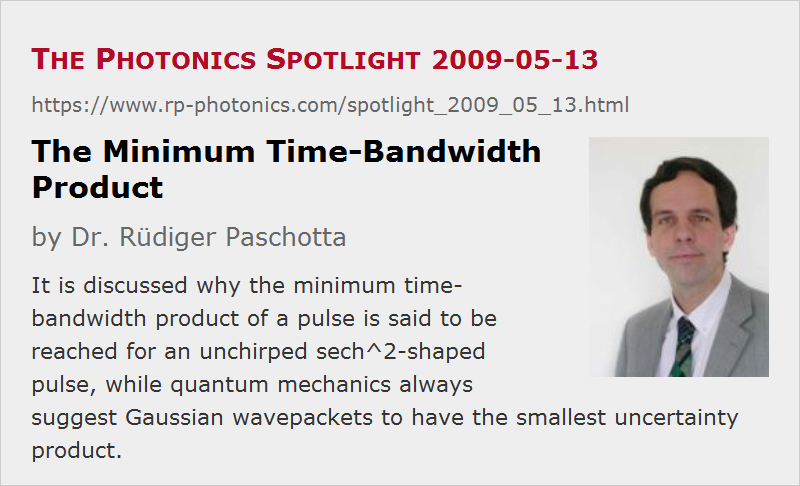The Minimum Time–Bandwidth Product
Posted on 2009-05-13 as a part of the Photonics Spotlight (available as e-mail newsletter!)
Permanent link: https://www.rp-photonics.com/spotlight_2009_05_13.html
Author: Dr. Rüdiger Paschotta, RP Photonics Consulting GmbH
Abstract: It is discussed why the minimum time-bandwidth product of a pulse is said to be reached for an unchirped sech^2-shaped pulse, while quantum mechanics always suggest Gaussian wavepackets to have the smallest uncertainty product.

Ref.: encyclopedia articles on time–bandwidth product, pulse duration, bandwidth
Isn't it strange: the minimum time–bandwidth product of an ultrashort pulse is said to be reached when the pulse is sech2-shaped, whereas in the context of quantum mechanics Gaussian-shaped wavepackets are said to have the smallest possible product of location and momentum uncertainty. Given that these relations are mathematically very similar, how can different shapes result?
The origin of that conundrum is related to the definitions of the involved quantities. The pulse duration and the optical bandwidth are usually defined as a full width at half-maximum (FWHM) values. In quantum mechanics, however, the second momentum of such a distribution is usually used for defining its width. In the latter case, Gaussian-shaped wavepackets have the smallest uncertainty product.
The quantum-mechanical habit is in a way more convincing, as a FWHM-based definition is not taking into account the wings. The sech2-shaped pulse looks better in terms of FWHM, but it has substantially stronger wings than a Gaussian pulse. However, FWHM-based width definitions are just very common in the technology of pulsed lasers, and instead of trying to change the usual definition, we should just keep in mind such issues in order not to fall into certain traps.
By the way, it is not even true that an (unchirped) sech2-shaped has the smallest possible time–bandwidth product. There are some pulse shapes with even stronger wings, exhibiting still lower products.
This article is a posting of the Photonics Spotlight, authored by Dr. Rüdiger Paschotta. You may link to this page and cite it, because its location is permanent. See also the RP Photonics Encyclopedia.
Note that you can also receive the articles in the form of a newsletter or with an RSS feed.
Questions and Comments from Users
Here you can submit questions and comments. As far as they get accepted by the author, they will appear above this paragraph together with the author’s answer. The author will decide on acceptance based on certain criteria. Essentially, the issue must be of sufficiently broad interest.
Please do not enter personal data here; we would otherwise delete it soon. (See also our privacy declaration.) If you wish to receive personal feedback or consultancy from the author, please contact him e.g. via e-mail.
By submitting the information, you give your consent to the potential publication of your inputs on our website according to our rules. (If you later retract your consent, we will delete those inputs.) As your inputs are first reviewed by the author, they may be published with some delay.
 |



If you like this page, please share the link with your friends and colleagues, e.g. via social media:
These sharing buttons are implemented in a privacy-friendly way!